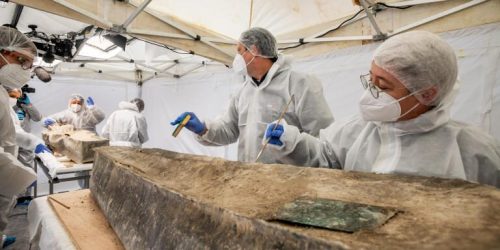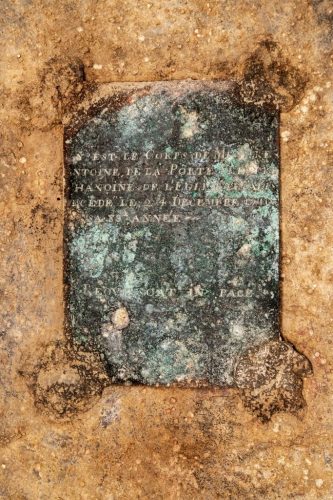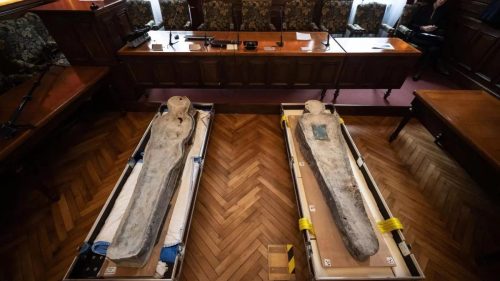
The Notre Dame Cathedral in Paris stands as an iconic symbol of France, a testament to centuries of history and artistry. While the devastating fire in 2019 threatened the existence of this cultural treasure, the restoration efforts are well underway. Amid the extensive reconstruction work, one often overlooked aspect of the cathedral’s history is the collection of sarcophagi hidden within its walls. These ancient burial chambers hold fascinating stories waiting to be uncovered, offering a unique opportunity to delve into the lost histories of Notre Dame.
Unearthing the Past
The Notre Dame Cathedral, constructed between the 12th and 14th centuries, is a masterpiece of Gothic architecture. The cathedral’s history is intertwined with that of Paris itself, and it has witnessed countless historical events, from royal coronations to significant religious ceremonies. However, the fire in 2019 brought attention to a lesser-known aspect of the cathedral’s history—the presence of sarcophagi beneath its stone floors.
These sarcophagi are remnants of a bygone era, dating back to the medieval and Renaissance periods. The cathedral, as a religious institution and a significant cultural landmark, was the final resting place for numerous dignitaries, religious figures, and individuals of high social standing. Over the centuries, they were entombed in these ornate stone coffins as a mark of their importance in society.
A Glimpse into the Past

Restoration efforts within Notre Dame provide an opportunity to uncover the lost histories of these sarcophagi. They offer a unique glimpse into the lives, beliefs, and customs of the people who lived during a time when the cathedral was at the heart of Parisian life. Each sarcophagus represents a story waiting to be told.
Among the most famous is the tomb of King Henry II and Catherine de’ Medici, who ruled France in the 16th century. Their ornate tomb is a masterpiece of Renaissance sculpture and an important artifact of the era’s artistic and political influences.
Another notable sarcophagus is that of Jean de La Fontaine, the famous fable writer. His tomb stands as a testament to French literature and its enduring impact on the world.
Challenges of Restoration
The restoration of these ancient sarcophagi is not without its challenges. The fire and subsequent water damage have left these stone coffins in a fragile state. The delicate carvings, inscriptions, and artistic details are at risk of being lost forever without meticulous restoration efforts.
Preservation experts, archaeologists, and conservators are working tirelessly to document and restore these pieces of history. They employ advanced techniques such as 3D scanning, laser cleaning, and microclimatic monitoring to ensure that the sarcophagi are brought back to their former glory while safeguarding their integrity.
The Role of Technology
Modern technology plays a crucial role in the restoration process, aiding in the documentation, analysis, and preservation of these priceless relics. 3D scanning allows for highly detailed digital replicas of the sarcophagi to be created, providing a blueprint for restorers. Laser cleaning techniques delicately remove centuries of grime, revealing the intricate carvings and inscriptions hidden beneath the surface.
Microclimatic monitoring ensures that the environment around these sarcophagi remains stable, preventing further deterioration. The use of these technological advancements ensures that the restoration process is not just a repair job but a journey into the past, uncovering the lost histories of Notre Dame.

Rediscovering the Lost Histories
The restoration of the sarcophagi within Notre Dame Cathedral is more than a mere conservation effort; it is an opportunity to rediscover the lost histories of France. These burial chambers hold secrets waiting to be unveiled. Through the intricate details carved into the stone, the inscriptions, and the artistry, we can learn about the society, culture, and beliefs of the times when these individuals lived.
For historians, archaeologists, and art enthusiasts, this restoration project is a dream come true. It offers a rare chance to connect with the past and to learn from the exquisite craftsmanship of the bygone eras.
Cultural Significance
The Notre Dame Cathedral is more than a religious monument; it’s a cultural treasure that represents the rich tapestry of France’s history. The restoration of the sarcophagi underscores the significance of preserving our heritage for future generations. It’s a testament to the resilience of human spirit in the face of adversity and a commitment to safeguarding the stories and legacies of those who came before us.
As the restoration project continues, visitors to Notre Dame Cathedral will have the opportunity to witness the intricate work being done to preserve and showcase these remarkable artifacts. It’s a chance for people from around the world to connect with the past and appreciate the invaluable history that Notre Dame holds within its ancient walls.

The restoration of the sarcophagi within Notre Dame Cathedral is a journey through time, a quest to uncover the lost histories of France. These stone coffins are not just relics of the past; they are windows into the lives, beliefs, and achievements of those who once walked the streets of Paris. With the aid of modern technology and the dedication of skilled professionals, these invaluable treasures are being meticulously preserved and restored.
The Notre Dame Cathedral is rising from the ashes, and in doing so, it brings with it the opportunity to restore and share the lost histories concealed within its walls. As the restoration efforts progress, these remarkable sarcophagi will continue to captivate the world, reminding us of the enduring importance of preserving our shared heritage for future generations. Notre Dame, with its rich history and storied past, is indeed an eternal beacon of art, culture, and history that will continue to inspire and enchant for centuries to come.






